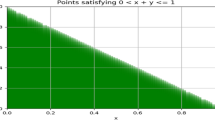Summary
This experiment investigated the possibility that the typical errors found on set inclusion tasks may be attributable to subjects interpreting all fuzzily and believing that it permits exceptions. The first part of the experiment used a questionnaire which demonstrated that some subjects did regard all as an appropriate quantifier when one exception to the generalization existed. In the second part of the experiment it was found that such fuzzy interpreters were more likely to make conversion errors than subjects who adopted a strict logical interpretation; however there was no difference in the number of errors made on transitive inferences. Hence fuzzy interpretation seems to be partially responsible for set inclusion performance, but clearly other factors are involved as well.
Similar content being viewed by others
References
Begg, I., & Harris, G. (1982). On the interpretation of syllogisms. Journal of Verbal Learning and Verbal Behavior, 21, 595–620.
Ekberg, P.S., & Lopes, L.L. (1980). Fuzzy quantifiers in syllogistic reasoning. Göteborg Psychological Reports, Number 6, Volume 10.
Griggs, R.A. (1976). Logical processing of set inclusion relations in meaningful text. Memory and Cognition, 4, 730–740.
Griggs, R.A., & Warner, S.A. (1982). Processing artificial set inclusion relations: Educing the appropriate schema. Journal of Experimental Psychology: Learning, Memory, and Cognition, 8, 51–65.
Johnson-Laird, P.N. (1970). The interpretation of quantified sentences. In: G.B. Flores D'Arcais & W.J.M. Levelt (eds.), Advances in Psycholinguistics. Amsterdam, North-Holland.
Johnson-Laird, P.N., & Steedman, M. (1978). The psychology of syllogisms. Cognitive Psychology, 10, 64–99.
Kyburg, H.E. (1983). Rational belief. Behavioral and Brain Sciences, 6, 231–273.
Mynatt, B.T., & Smith K.H. (1979). Processing of text containing artificial inclusion relations. Memory and Cognition, 7, 390–400.
Neimark, E.D., & Chapman, R.H. (1975). Development of the comprehension of logical quantifiers. In: R.J. Falmagne (ed.), Reasoning: Representation and Process. Hillsdale, N.J., Erlbaum.
Newstead, S.E., & Griggs, R.A. (1983). Drawing inferences from quantified statements: A study of the square of opposition. Journal of Verbal Learning and Verbal Behavior, 22, 535–546.
Oden, G.C. (1977). Integration of fuzzy logical information. Journal of Experimental Psychology: Human Perception and Performance, 3, 565–575.
Rosch, E., & Mervis, C.B. (1975). Family resemblances: Studies of the internal structure of categories. Cognitive Psychology, 7, 573–605.
Author information
Authors and Affiliations
Rights and permissions
About this article
Cite this article
Newstead, S.E., Griggs, R.A. Fuzzy quantifiers as an explanation of set inclusion performance. Psychol. Res 46, 377–388 (1984). https://doi.org/10.1007/BF00309070
Received:
Issue Date:
DOI: https://doi.org/10.1007/BF00309070




